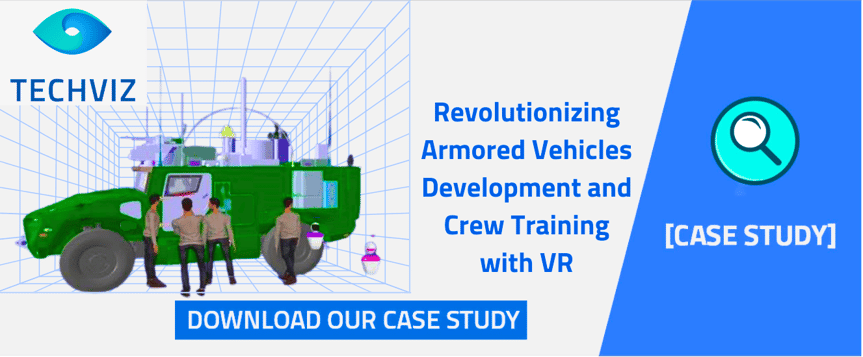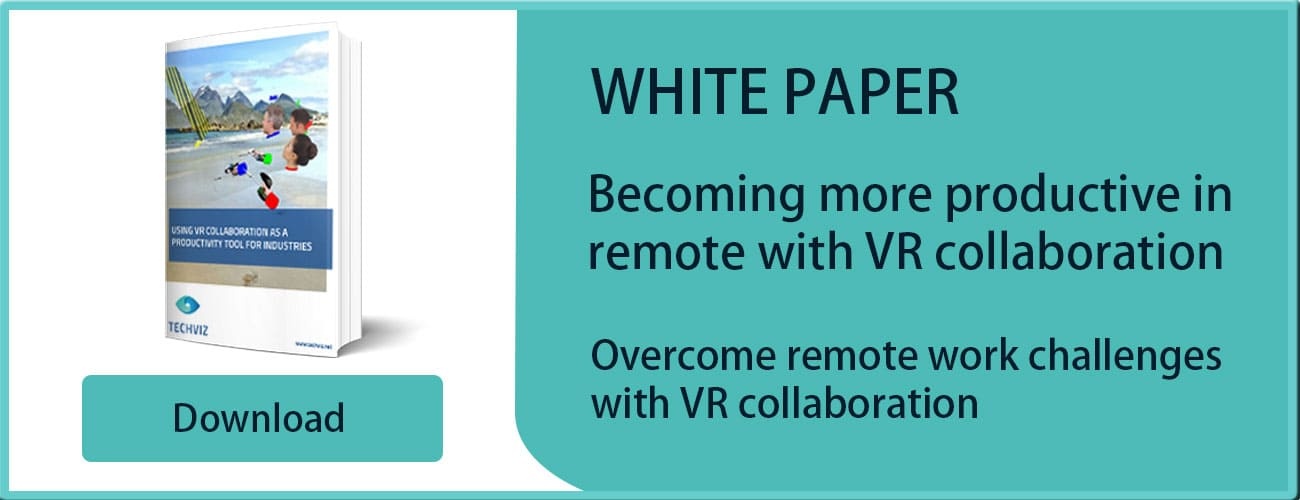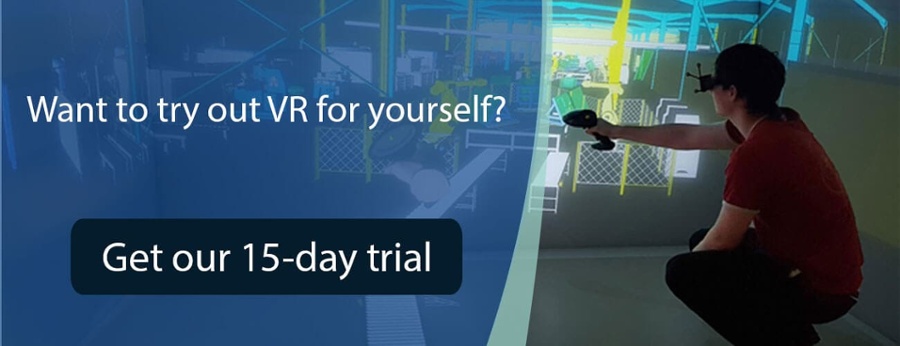.jpeg?width=863&height=432&name=military-2-2%20(1).jpeg)
The history of VR has often been influenced by the defense industry. One of the first VR projects was developed in the 1960s for a US military combat system. Virtual reality has always played a significant role in the military field and was adopted by all services: Army, Navy, and Air Force. It is mostly used for Army training purposes, but there are other use cases where VR is a powerful tool.
“We need to train the way we fight and fight the way we train.”
Virtual reality is a computer-generated environment that enables the viewer to immerse themselves in their 3D data. Military and defense are one of the industries where virtual and augmented reality technologies are most widely used. VR is even one of the key technologies listed by the US Department of Defense in the 21st century. In this article, we will discover the current uses of Virtual Reality in the Defense/Military sector.
How is VR used in the Military and Defense industries?

1. Specialized Military Training in Virtual Reality (VR)
Virtual reality training is a common use case for VR technology. It helps for training exercises that are too rare, too expensive, or too dangerous to be done in real life. Training simulation in the military field fosters the combat skills of small-scale units or single soldiers by simulating actual vehicles, soldiers, and combat environment.
According to a report by HTC Vive, 80% of active-duty military trainers who used VR for training reported an increase in their crew's confidence, attributed to the cultivation of the required muscle memory (Cognitive Muscle Memory Development) for successful application.
Depending on the virtual reality experience, it might deal with sensitive data or only involve a select few individuals. “Classic” VR solutions will have trouble dealing with a restricted audience and/or particular use cases. A versatile solution like TechViz software will probably suit you better if you are looking for specialized VR training solutions.
Virtual boot camp and combat training
Some military bases in the US are using immersive rooms to train their soldiers. Virtual Squad Training System (VSTS) located at Schofield Barracks in Hawaii uses HMD with motion trackers, full-body tracking system and wireless weapon controllers that matches the size, weight, and shape of real military weapons. Such virtual reality systems teach participants how to work interdependently and the impact they can have on their colleagues on the battlefield.
Virtual training for providing efficient medical response in high-stress situations /Tactical Combat Casualty Care (TCCC):
Military members (including, but not limited to medics) regularly encounter extreme situations that are difficult or impossible to duplicate in traditional simulations. With VR, trainees get the chance to experience a real-like environment and scenario and work through the most effective response. Covered skills can include battlefield triage, specific trauma treatment, helicopter rescue and tactical rescue procedures.
This training is so important and effective that every single member of the military, even those not in combat, is required to take it.
Maintenance and assembly technicians training
In this sector there are very few experienced support personnel, and their knowledge must be transferred somehow. The use of virtual and mixed-reality technologies is a solution for this challenge. As an example, in the marine corps, each boat can have specific engineering constraints, leading to a different maintenance scenario from a boat to another. To be immediately operational, technicians can view the CAD model in VR and get an army specialized training program “on the boat” before their operation.

2. Advanced Virtual simulations for the military and defense
Advanced Flight Simulation
Military flight simulators are critical for training pilots. High-fidelity simulations help to safely expose and prepare pilots-in-training for challenging real-world scenarios as well as dramatically reduce training time. For example, Boeing managed to cut training time by 75 percent thanks to VR technology.
Mixed simulations for an unparalleled battlefield situation reproduction: Thanks to the possibility of combining several specialized simulators into one, it is now feasible to recreate a battlefield scenario by merging two or more simulators, each specializing in one particular simulation (e.g., flight, weaponry) without having to compromise on the quality of either.
For example, it is possible to have a flight simulator overlaid with a virtual world rendering an actual battlefield for a complete pilot training (this type of virtual reality simulation can be done using TechViz Fusion). All the user’s senses can be stimulated to fully recreate the pilot training.
Advanced Ground Vehicle Simulation
Ground vehicle simulators provide a safe environment for drivers, by immersing them in a replica of a military vehicle. Virtual training can help you simulate different events like vehicle collisions or hostile armed forces. But it can also help you check the ergonomics of the cockpit you’re simulating, by seeing in a real situation (almost), if the instrument panel is comfortable to use, and if all the buttons and commands can be reached out.
[ Download TechViz's recent Case Study "Revolutionizing Armored Vehicles Development and Crew Training with VR" ]
Equipment Familiarization Training
A lot of heavy equipment and military vehicles are intensive and complex electromechanical systems. Knowing how they function and how to operate them safely is an essential training for participants who need to familiarize themselves on a particular piece of equipment, to help refresh and develop their existing skill set.
3. Design, Optimization & Maintenance of Defense Equipment
Maintaining and optimizing military equipment with virtual reality
A lot of defense equipment are intensive complex electromechanical systems, such as aircrafts, spacecrafts, ships… And, of course, not all equipment is used in the conditions the engineers had in mind when they conceived it. Virtual reality is the perfect tool to conceive and optimize military equipment. For example, some vehicles can end up being used in other climatic or environmental conditions. In any cases, if the end users notice what parts are showing excessive wear, the information can travel back to the design teams, so that the next designed model (or just the fixing parts) will be better.
Manufacturing new weapons in VR
Virtual reality has changed the way we design products, whether from a conception or a testing standpoint. It is a powerful tool for industries embracing Industry 4.0, like the defense industry. During weapon development, immersive virtual reality helps engineers:
- Test the design in virtual worlds and/or with a motion-tracking
- Operate weapons “for real” with haptics
- Add tactical and technical performance data
VR speeds up product development for the new weapons or military installations and betters their overall effectiveness and quality. This is particularly effective when developing large-scale products such as an aircraft or a ship. Virtual reality technology helps you visualize your designs at 1:1 scale and make changes in real time.
Besides, with cloud technologies and 5G becoming more and more common, military research labs will also need to collaborate seamlessly with one another, even when they are distant from thousands of kilometers. This particular use case happened with TechViz VR remote collaboration software, which helped two labs designing nuclear submarines with VR remote collaboration. One research facility was located in France and the other in New Zealand. By using our software they were able to do virtual reality design reviews, interact simultaneously with large-scale CAD models in VR with military-grade data-security.
4. Remote collaboration on sensitive defense projects or military missions
Collaboration in VR between distant sites is important today, especially when anticipating the future of work. However, videoconference tools offer a limited immersion when it comes to complex tasks. With a virtual reality system, several users can work on the same 3D models, at real scale and in real time. Remote work in VR is crucial when countries are sharing military assets and/or research to create a virtual prototype.
On a military mission, this feature can serve for another use case. It can allow an operator to get data from a location, without being physically present. It opens new possibilities for information gathering operations in hostile territory, as the operator will be able to move the sensors, while being in a realistic rendering. It makes the operation safer and increases the stealth of the agent, as the reconnaissance vehicle does not need to transport real passengers.

What key benefits does VR offer to the Military and Defense industries?
Natural actions and movements with most of AR/VR hardware
When you are immersed in your 3D data, VR hardware allows for natural actions in a virtual environment. Ease of movements happens regardless if you use a standalone head mounted display (HMD), or a projection-based VR hardware. The only difference will be the level of immersion: all-in-one or tethered virtual reality headsets will provide your recruits with a fully immersive experience, compared to a PowerWall or a CAVE system. Being able to train in real-like conditions greatly reduces the potential for training gaps.
Train anytime anywhere for any situation with all-in-one VR headsets
The use of an all-in-one VR headset such as the meta quest 2, the HTC VIVE Focus or the Microsoft Hololens 2 enables trainees to roam freely in a fully configurable area. It revolutionizes the way you prepare your men by transforming any location into a dynamic training ground.
Lifelike training without the associated risks
Virtual reality allows soldiers to train for real situation without risks, with feel-real weapons and vehicles. In a simulation, any equipment can be created in the virtual platform. You can even add tracking devices with haptic feedbacks to give the trainees a more natural training experience. High-risk scenarios can be simulated without danger, allowing soldiers to learn how to act in specific scenarios that could be too dangerous or too expensive in real life, such as parachute training.
Scalable and adaptable VR Simulations
Depending on your needs, you can create a fully-adaptable virtual reality simulation depending on how the trainees are reacting. The same VR scenario can have different outcomes, helping participants to adapt to any situation. Trainees can focus on the learning outcomes, as they will need less time to adapt to the real situation in the real world.
Detailed 3D reviews in different viewpoints
Depending on your hardware and 3D model, you will be able to record your VR sessions from different viewpoints. This is important for example if you want to collect information on how to improve the model of a three-dimensional vehicle with real users, or get personalized inputs for your trainees.
Reduced costs for training and engineering
Virtual reality reduces the need for physical prototypes. It’s a key benefit for design and engineering, as the team won’t have to send as many physical models back and forth, and instead work simultaneously in the same VR environment. For training purposes, virtual and augmented reality sessions can open the possibilities for group and individual training, even for scenarios that could be too expensive or too dangerous to do in a real training.
Overcoming the current Training Crisis and engaging New Recruits
According to Military Times, the Army missed its recruitment goal by 25% in 2022.
This is in part due to the differences in learning patterns and world perception of the individuals primarily targeted by military recruiters.
Members of Generation Z have grown up with a stronger emphasis on visual learning compared to previous generations, and the classroom + PowerPoint presentations simply don't work anymore.
It may seem surprising, but what strongly resonates with the newer generation of military recruits is [video] gaming (in fact, 86% of airmen and guardians under 34 are gamers).
Therefore, utilizing VR not only allows new recruits to train in highly realistic conditions but also enables military recruiters to meet them where they are and keep them engaged throughout the entire process.
Other articles about VR that might interest you
- The complete guide of VR for business
- Best AR/VR Headsets for engineers in 2022
- VR motion sickness: how to reduce it in your professional use?






 Back to Blog
Back to Blog
.jpeg?width=863&height=384&name=FHK2LQ4IOVEMTFHAH7B7OTXGZA-jfif-1-1%20(1).jpeg)




